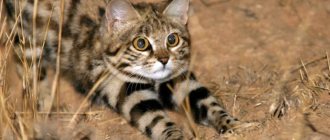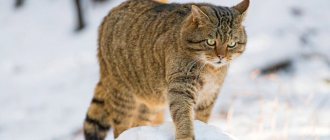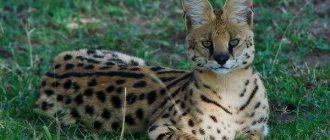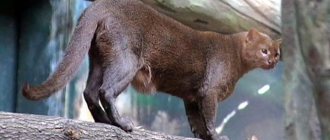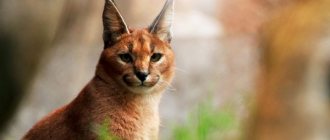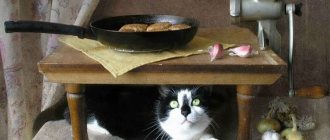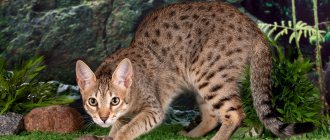History of the origin of the breed
The era of the Quaternary period - the Pleistocene, which began more than 2.5 million years ago and ended approximately 11.5 thousand years ago, according to scientists, is the time of the emergence of the wild cat. Based on these figures, it is obvious that the wild cat is “older” than humanity, which arose about 2000 years ago; scientists do not know what it might have looked like at that time.
Typical wild forest cat
The end of the Ice Age, harsh climate, terrible weather conditions, followed by global warming, influenced the emergence and further development of the wild cat class.
Habitat of the European Forest Cat
Caracal cat breed or wild steppe lynx
Wild cats in nature live both in deciduous and coniferous forests, as well as in mountainous areas and even on cliffs 2–3 km high. The American sometimes settles on the banks of rivers and lakes, in dense bushes and reeds.
Temporary and permanent homes were found for this animal. Temporary ones include depressions, holes, abandoned bird nests, or simply intertwining branches. A permanent shelter is abandoned badger and fox holes or hollows of large trees.
Hybrid breeds of jungle cats
Since it is difficult to purchase a true reed lynx for your home for many reasons, you can consider purchasing hybrids of a wild cat and an Abyssinian cat. As a result of crossing, kittens called Chausie or Houseie are obtained. Chausie F1 (first generation hybrid) will differ from subsequent generations in a cooler disposition.
The Hausi cat can be placed in an apartment and enjoy its exotic appearance and friendly character. The breed was officially recognized in 2003, and since then it has had many admirers. Thanks to our crossbreeding work, we have the opportunity to keep at home an animal that retains the appearance of a wild cat and the easy-going, good disposition of the Abyssinian.
Number of species
Cat with tufted ears: examples of domestic breeds
Due to the emergence of cities and suburban areas, the number of forest kittens is rapidly declining. For example, in Europe there are almost none left, since there are few forests in this part of the planet. And only 2–3 cats live per 1 km2.
With the development of urban landscapes and the destruction of forests, small rodents, the main food of wild cats, are also disappearing. This significantly affects the decline of the species. The forest cat has a very valuable skin with interesting spots, which many hunters dream of getting.
Valuable wild cat skin
Important! Being endangered, the forest cat is listed in the Red Book of many countries, for example, Belarus.
In Russia you cannot kill these animals
Lifestyle and nutrition
With approximately 40 species of cats, with the exception of Australia, cats are represented in all parts of the world. However, cats do not go as far north as bears and dogs, and are completely absent from Iceland and Madagascar.
Most large species are characteristic of predominantly tropical and subtropical countries. Apart from our domestic cat, which helps us in many ways to understand the nature of these animals, all cats eat exclusively meat. Video about the forest cat:
Most of them eat only freshly killed prey, and only those forced by hunger resort to carrion. They attack their prey suddenly, having previously approached it with great caution. All cats hunt alone, with the exception of lions.
Appearance and breed standard
This mammal is similar in appearance to an ordinary domestic cat, but slightly different in size. A wild cat can have different names, reach up to 90 cm in length and weigh up to 9 kg.
Norwegian Forest Cat - description of Scandinavian cats
For example, Soviet cats have a very strong and muscular build. The limbs are of medium length. At the end of the paws there are sharp claws that retract into the pads when walking, which help the cat climb rocks and trees.
Interesting! The fur is evenly distributed throughout the body, much more on the tail. Color – gray with patterned lines on the head, back, sides, tail.
The tail is shorter than that of a domestic cat, has about 8 encircling stripes and has a blunt end. The head is large with very developed cheekbones and large jaws. Widely spaced ears, about 6 cm in length, have an inner edge, the tips without tassels.
The eyes, with slit-like vertical pupils, are located close to each other and have a greenish-yellow color. Small but very sharp teeth. A wild cat has long white whiskers (vibrissae), about 15 on each side and up to 8 cm long. They usually have four pairs of nipples - two on the chest and two on the belly.
Some differences between subspecies
There are 23 subspecies of forest cats. The most common: Central European, Caucasian, Turkestan, Omani, steppe, African and Chinese.
The Central European subspecies is larger than its steppe relatives. Adults reach a weight of up to 16 kg. The closest relatives of forest cats include marsh lynxes and manul cats. The wild cat has a very wide habitat; for example, the Scottish and American subspecies are known.
Forest cat at home
Keeping such animals at home is very difficult. Wild habits are genetically embedded in a forest cat, so training and education will not be able to change its character, and an alliance with a person is hardly possible.
When bringing even a small wild kitten into your home, you should think about a spacious enclosure in which it will live. A wild animal should not be near domestic animals, which it will probably hate. An attempt to coexist may end tragically.
Important! It is necessary to carefully monitor the health of the forest predator, get vaccinated on time and undergo examinations by a veterinarian.
Don't forget about special nutrition. The daily diet must be selected carefully. The forest cat loves lean meat, fresh fish, offal, dairy products and eggs. Just like all living beings, he needs a vitamin and mineral complex. Young grass and oat seedlings are well suited for this.
The most favorable existence of a forest predator in captivity is created in zoos, and not in ordinary villages. In conditions close to natural, animals live long and reproduce successfully.
Wild kittens in the zoo
Appearance of wild forest cats
In appearance, a wild forest cat is very similar to domestic pets, but it is much larger than them. The body is denser, the coat is short and thick. This coat color promotes camouflage in the wild. Dense, tall and thick fur protects from the cold.
The weight of males can reach 8–10 kilograms, females are slightly smaller and weigh about 5 kilograms. The length of the body without a tail is from 40 to 90 cm, the tail is fluffy with a tassel, the length of which reaches 25–30 cm. Sharp small teeth and large powerful claws help to survive in the harsh realities of the wild.
Wild forest animals have sensitive vision and keen hearing. These are beautiful and graceful cats with powerful hind legs that can move quickly. Wild forest cats are not as friendly as their domesticated relatives.
There are different types of forest cats:
- The Scottish forest cat lives in northern Scotland in juniper thickets and small plantings. Hunts at night for rabbits, mice, birds and small rodents. A nature reserve has been created on the west coast of Scotland to save an endangered species. Today there are approximately 35 purebred Scottish forest cats.
- The Caucasian forest predator lives in the mountains of the northern Caucasus. This is a very rare species that is on the verge of extinction.
- The Far Eastern leopard cat lives in Primorye, less often in China. The local name Amur forest cat comes from the Bengal cat with a characteristic brown coat color and red spots. It hunts at night and lives in the densest impenetrable thickets.
- In the south of Russia, a forest cat lives in the reed thickets in the Astrakhan region. The reed forest cat breed is very similar to the swamp lynx.
- The wild forest cat of America, the ocelot, lives in South America. The low population of the American forest cat could lead to its complete extinction. This species is listed in the Red Book.
- The European wild cat is large, has a thick coat, light color from light gray to brown, with dark transverse rings on the sides, and stripes on the tail. Habitat: Europe, Western Ukraine, territory of Belarus, North Caucasus. They settle in forests, climb mountains, hunt not only small rodents, but also hares, rabbits, and young roe deer.
- The African golden cat, despite its beautiful color, has a very capricious and evil character. Reaches a weight of 14 kilograms, hunts every day small antelopes, gazelles and birds, and does not disdain small monkeys.
Character and behavior
Forest cats are solitary predators. Very cautious and timid. They do not like strangers and do not always find contact with their relatives. They avoid human settlements, trying not to be seen by people.
Adults control a forest area up to 3 km. sq. To prevent enemies from entering the cat’s territory (lynx, fox, wolf, jackal, bear, large steppe cat, marten). The forest cat leaves its characteristic scent on trees, bushes, stumps and stones. It rubs its head or the back of its body, thus making messages for other individuals.
This is a nocturnal animal. During daylight hours, it rests and sleeps in its den. One and a half to two hours before sunset and several hours before dawn, it goes out for prey, which can even be a deer. The exception is mating periods, when the male needs to leave his habitat in search of a female.
The forest predator has well-developed hearing, vision and sense of smell. It is silent, but, like a domestic cat, it is capable of meowing, purring, snorting, hissing and purring. This animal is very fast, capable of developing enormous speed. Thanks to this, it has the opportunity to catch up with the victim and escape from enemies.
Important! Sneaks up on the victim unnoticed. Before directly attacking the prey, it sits in ambush.
Jungle cat at home
No matter how much you try to dissuade those who want to put a wild creature in their home, it will be of no use. It’s better to talk about how a domestic jungle cat .
Maintaining such an unbridled and active creation of a house will not bring pleasure to people who value their furnishings - everything that was in its place will be chewed, turned over or torn off. For home keeping, it is better to provide the animal with conditions close to natural, for example, organize an enclosure with a pond.
What does a domestic cat (reed cat) do in the house? He gallops as hard as he can around the rooms, rushes like the wind, jumps around the corner onto the owner’s feet, immediately rushing off and disappearing under the closet, as if in a secret lair. To prevent the animal from becoming the absolute master of the house, they begin to educate it from early childhood, simultaneously accustoming it to a scratching post and a tray. To satisfy the natural needs of hunting, you will need to treat the Hausa with live food.
Buy a jungle cat kitten
global $ads_google; //data-ad-slot=”2475549904″ $ads_google = empty($ads_google) ? false : true; ?> if ($ads_google == false) {?>
$ads_google = true; ?> } ?>
It is unlikely that anyone will be able to buy a marsh lynx in Russia, since there are no nurseries selling reed kittens here. Of course, you can find an advertisement on some website for the sale of a reed kitten, but is it really such, because you can buy an ordinary yard cat for a fabulous price.
If you have a wild desire to buy a Hausa, then you should not trust illegal sources that are not able to document either the purity of the breed or the state of health of the animal. In addition, when poachers offer an animal from the wild, and not one raised in a nursery in an enclosure, one should not even hope that the cat will become a pet.
The cost of a reed kitten will be no less than 3-8 thousand dollars, so a lower price should alert buyers.
What does the European wild forest cat eat?
It eats a very varied diet, but large animals are not included in the diet, unless they are young. Prefers to hunt birds, rodents, hares, rabbits, snakes, insects, ferrets. Like domestic cats, they don’t like to swim, but they know how, so sometimes they don’t mind diving into a pond and feasting on freshwater fish, crayfish, mollusks, and snails.
Loves to gnaw on various plants, including ordinary grass. Therefore, at home it can easily ruin indoor flowers, even your favorite orchid.
Wild cat nutrition
Important! These are very voracious animals. An adult eats up to two kilograms of meat per day; a three-month-old kitten can eat up to 10 mice.
Reproduction
They reach sexual maturity at about three years of age. The mating season usually falls between January and March. The female, ready for fertilization, releases a specific aroma, the smell of which cats are drawn to. The males, gathering in a group, win the cat by fighting with each other. It often happens that among the males there are feral domestic cats lost in the forest. Therefore, it happens that the population mixes. After conception, the female prepares a den for herself.
Pregnancy of a wild cat lasts from 2 to 2.5 months. At one time, a cat manages to bear from 2 to 7 kittens, which are born blind, deaf and with small fluff on the body. After the birth of the kittens, the male leaves the female, returning to his usual life.
Until 3-4 months, the cubs are fed with mother's milk. They are under constant maternal protection from enemies. Babies live with their mother for up to 6 months. At this age, they already know how to hunt and climb trees. From nine months, female cats are ready to breed.
Wild cat ready to breed
Reproduction and kittens
The breeding season of Pallas cats coincides with the courtship season of other cats. At the end of February and beginning of March, males begin to look for a female for procreation .
Approaching the chosen one, the cat is unusually wary. He brings his girlfriend delicious gifts and bravely drives her competitors away. The estrus period for females lasts only two days, so the male has little time for the most important things. If conception does not happen, pregnancy will not occur this year.
